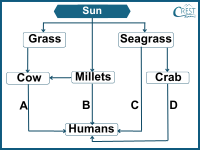1. In a forest ecosystem, if there are 1,000 primary consumers (herbivores) and they collectively consume 10,000 units of energy from plants, how much energy is transferred to the secondary consumers (carnivores).
a) 1,000 units
b) 100 units
c) 10 units
d) 1 unit
Answer: a) In a forest ecosystem, you have 1,000 primary consumers (herbivores) consuming 10,000 units of energy from plants. The energy transfer efficiency is 10%.
To find out how much energy is transferred to the secondary consumers (carnivores):
Energy transferred to secondary consumers = Energy consumed by primary consumers × Energy transfer efficiency
Energy transferred to secondary consumers = 10,000 units × 0.10 (10% as a decimal)
Energy transferred to secondary consumers = 1,000 units
2. Which of the following activities are typically involved in recycling programs?
I. Collection of recyclables
II. Separation of recyclables from non-recyclables
III. Incineration of non-recyclables.
IV. Treatment of recyclables to remove contaminants
V. Manufacturing new products from recycled materials
VI. Disposal of recyclables in landfills
a) I, II, and IV
b) I, II, IV, and V
c) II, III, IV, and V
d) I, II, IV, V, and VI
Answer: b) I. Collection of recyclables: Recycling programs start with collecting recyclable materials.
II. Separation of recyclables: Materials are separated from non-recyclables.
IV. Treatment of recyclables: Recyclables are treated to remove contaminants.
V. Manufacturing new products: Recycled materials are used to create new products, a key goal of recycling programs.
Options III (Incineration of non-recyclables) and VI (Disposal of recyclables in landfills) are not typically part of recycling efforts.
3. Consider the intertwined food chains depicted in the given figure. Identify the ones that contribute the highest energy to humans.

a) A and D
b) A and B
c) B and C
d) C and D
Answer: c) To identify the ones that contribute the highest energy to humans, we need to consider the trophic levels and energy transfer efficiency.
In food chains A and D, humans are at the third trophic level, which typically results in a lower energy transfer efficiency compared to lower trophic levels. This is because energy decreases as it moves up the food chain.
In food chains B and C, humans are at the second trophic level, which means they consume the primary producers (millets). This trophic level generally has a higher energy transfer efficiency compared to higher trophic levels Based on energy transfer efficiency, chains B and C are likely to contribute the highest energy to humans.
4. In a freshwater ecosystem, if the concentration of a bioaccumulated toxin in primary consumers is 10 ppm, what would be the expected concentration in tertiary consumers if biomagnification is occurring?
a) Less than 1 ppm
b) Approximately 10 ppm
c) Greater than 10 ppm
d) It would remain 10 ppm
Answer: c) If biomagnification is occurring in a freshwater ecosystem, the concentration of a bioaccumulated toxin increases as you move up the food chain from lower trophic levels (primary consumers) to higher trophic levels (tertiary consumers). This is because the toxin becomes more concentrated in the tissues of organisms at each successive trophic level.
Given that the concentration of the toxin in primary consumers is 10 ppm, we would expect the concentration to be higher in tertiary consumers.
5. In the following question, you will find an assertion and a reason. Select the appropriate option that applies.
Assertion: Chlorine is a significant contributor to the depletion of the ozone layer.
Reason: Chlorine atoms released into the stratosphere from the breakdown of chlorofluorocarbons (CFCs) can catalytically destroy ozone molecules.
a) Both the assertion and reason are true, and the reason is a correct explanation of the assertion.
b) Both the assertion and reason are true, but the reason is not a correct explanation of the assertion.
c) The assertion is true, but the reason is false.
d) The assertion is false, but the reason is true.
Answer: a) The assertion states that "Chlorine is a significant contributor to the depletion of the ozone layer," which is true. Chlorine, specifically in the form of chlorine atoms, is indeed a major contributor to ozone layer depletion.
The reason provided states that "Chlorine atoms released into the stratosphere from the breakdown of chlorofluorocarbons (CFCs) can catalytically destroy ozone molecules," which is also true. This is a well-established mechanism for ozone depletion, where chlorine atoms released from CFCs can destroy ozone molecules in a catalytic chain reaction and it correctly explains the assertion.


